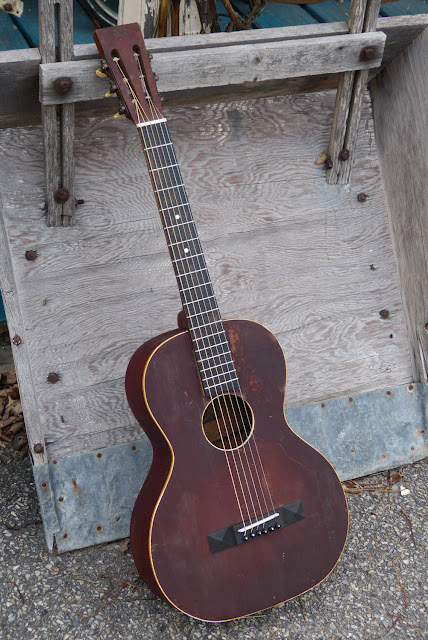1920s Oscar Schmidt-made FHCM Parlor Guitar
This old Schmidt has been in the workshop for an eternity and the gentle nudging of an interested buyer is what finally got me started on bringing it back to health alongside the other FHCM ("First Hawaiian Conservatory of Music") parlor I finished-up last week. These are great, woody-sounding, old-timey country-blues guitars and their sound can lean in most directions you may want to take a vintage flattop -- flatpicking, fingerpicking, slide -- you name it. The flatpicking part is especially interesting to me as so many ladder-braced, period guitars fall distinctly "flat" in that category. It's something about the fundamental, warm tone from that makes it work.
Anyhow, compared to the last FHCM, this one got a bit more love. It needed the usual neck reset and replacement bridge (the original, as usual, was split), but in addition to that it also received a non-adjustable steel truss rod, a board plane and refret, and a few of hairline crack repairs to the top (they're hard to see as they blend in with the finish "mojo"). It plays excellently, is strung with straight 12s, and has the typically-robust sound I associate with old Schmidts.
These guitars have solid birch bodies with poplar necks and originally have stained-maple fretboards and bridges. The bridge has been replaced here, however, with a new rosewood one that I've "ebonized" in an old-fashioned manner. It's roughly "0" size at 13 3/8" on the lower bout and has a 24 7/8" scale length and 1 7/8" nut width.
The nut and saddle are new, bone ones. Originally the nut on this was a tall, cruddy-wooden, Hawaiian (raised, slide-style) nut. The tuners are original and, after lube, work swell.
The board originally looked like the one on the other FHCM guitar, though I did a board level on this before I refretted it so I "ebonized" it like the bridge and then "aged" it to look closer to the appearance of an average Schmidt "Spanish guitar" fretboard.
I used medium-stock frets during the refret and replaced the damaged faux-pearl dots with real-pearl dots.
No -- the pinholes aren't drilled incorrectly -- but the pins are those old-style "non-slotted" ones and so they move a little bit wonkily when you pop the strings in. This is one of those standard replacement oversized pyramid bridges I often use, though I've ebonized it for a couple of reasons -- first to match the fretboard work and second to hide the fact that I relocated the pinholes a bit farther "aft" of the saddle.
The reason for relocating the pins is to get a 45-degree angle on the strings instead of something steeper behind the saddle. I didn't realize that I'd reset the neck a little too steep when I did the clamping and shimming-up of the funky neck joint during the reset. At least, however, there's "plenty of saddle" on this one! The bridge is also so heavy-duty that I hardly think that the tall saddle will impose any issues down the line.
This guitar has a lot of handling/storage wear. It's got that classic Oscar Schmidt "alligatored" look to its finish.
The top has two small hairlines and two longer ones fore and aft of the bridge. They're cleated, filled, and sealed and pose no issue to the guitar.
The back and sides are crack-free, however, and show a bit more of the original "ruddy-sunburst" look.
The top and soundhole edges are bound in cream celluloid.
The endpin hole on this was oversize (sometimes the Schmidt guitars had huge endpins) and so I plugged the hole and then reamed for a modern, ebony pin.
Here's the label inside.
Here's this guitar with its other FHCM stablemate. Both are the same size and have the same specs, bracing, and roughly the same feel. The necks on both are fairly big but this more-worn-in FHCM has a slightly-smaller, rounder neck profile.























Comments